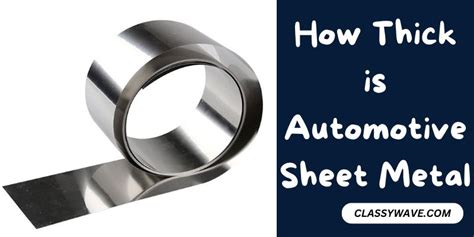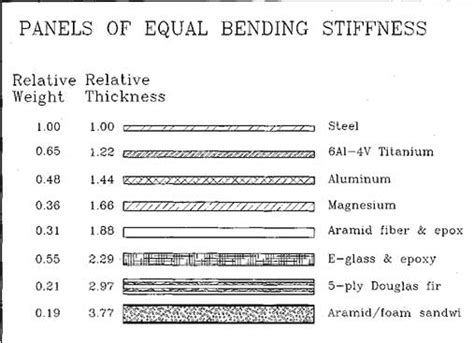car body sheet metal thickness If you have a set of calipers you can measure the thickness of the existing metal and then order what you need. Here's some of the common gauges and corresponding thickness of sheet steel: GA. Thickness.
The CNC milling machine combines the accuracy of computerized controls to rotate and position multi-point cutting tools. As the raw stock progresses through the pre-programmed machining operation, a tool moves along the three primary axes, X, Y, and Z to precisely cut away material.
0 · typical automotive sheet metal thickness
1 · typical auto frame steel thickness
2 · shrinking sheet metal bodywork
3 · ram promaster sheet metal thickness
4 · old car restoration sheet metal
5 · car sheet metal thickness mm
6 · auto body sheet metal thickness
7 · 20 gauge automotive sheet metal
A power distribution board, also known as a panelboard or fuse box, is a crucial component in both commercial and residential electricity supply systems. It acts as a central hub that connects the main power cable and facilitates the .
Sheet metal thickness is vital for vehicle durability. The standard measurement for this thickness is “gauge,” with a higher gauge number indicating a thinner piece of metal. The gauge system is often used in conjunction with . If you have a set of calipers you can measure the thickness of the existing metal and then order what you need. Here's some of the common gauges and corresponding .
A final characteristic of auto body sheet metal that should be considered is its basic gauge or thickness. There are half a dozen gauge wire and sheet steel gauge standards . The thickness of automotive sheet metal directly influences the weight of the vehicle. Thicker sheets add to the overall weight, affecting fuel efficiency and handling. However, it’s a delicate dance, as thicker metal also .
Sheet metal thickness is vital for vehicle durability. The standard measurement for this thickness is “gauge,” with a higher gauge number indicating a thinner piece of metal. The gauge system is often used in conjunction with millimeters to specify the thickness of metal. If you have a set of calipers you can measure the thickness of the existing metal and then order what you need. Here's some of the common gauges and corresponding thickness of sheet steel: GA. Thickness.
A final characteristic of auto body sheet metal that should be considered is its basic gauge or thickness. There are half a dozen gauge wire and sheet steel gauge standards running around out there, but automotive material is generally described by the “Manufacturers Standard Gauge for Sheet Steel” standard. The thickness of automotive sheet metal directly influences the weight of the vehicle. Thicker sheets add to the overall weight, affecting fuel efficiency and handling. However, it’s a delicate dance, as thicker metal also enhances structural integrity, contributing to the vehicle’s safety.
What thickness or gauge is standard automotive sheetmetal on American vehicles, such as a door skin or fender skin. I'm practicing up on my Mig and am trying to determine settings, using ER70-6S and C25.
The perfect size for automotive sheet metal is between 18 to 20 gauge. 20 gauge is the most used gauge sheet metal for automotive functions. The abundant metal will be 0.0478 to 0.0359 inches and still need to be cautious about the bumper and metal finish.The chart below can be used to determine the equivalent sheet thickness, in inches or millimeters, for a gauge number from the selected gauge size standard. The weight per unit area of the sheet can also be seen in pounds per square foot and kilograms per square meter.The standard thickness of sheet metal is below 6.35 mm [2]; however, mild steel sheets of 0.45 mm to 1.2 mm (gauge 18,20,22,24) are more typically used in modern urban environments [3], with. The metal sandwiched together on the bottom inside of the rocker panels, some of it is .060 and .040 thick, so when you're working different panels and braces, be aware you have different thickness's of sheet metal.
Car Body Sheet Metal. Alloy: 5052, 5182, 5754, 6016, 6014, 6111. Temper: O, H32, T4, T6. Thickness: 0.5-600mm. Width: 20-2600mm. Application: Car body. Request A Quote

stainless steel meal box
typical automotive sheet metal thickness

Sheet metal thickness is vital for vehicle durability. The standard measurement for this thickness is “gauge,” with a higher gauge number indicating a thinner piece of metal. The gauge system is often used in conjunction with millimeters to specify the thickness of metal. If you have a set of calipers you can measure the thickness of the existing metal and then order what you need. Here's some of the common gauges and corresponding thickness of sheet steel: GA. Thickness.
A final characteristic of auto body sheet metal that should be considered is its basic gauge or thickness. There are half a dozen gauge wire and sheet steel gauge standards running around out there, but automotive material is generally described by the “Manufacturers Standard Gauge for Sheet Steel” standard. The thickness of automotive sheet metal directly influences the weight of the vehicle. Thicker sheets add to the overall weight, affecting fuel efficiency and handling. However, it’s a delicate dance, as thicker metal also enhances structural integrity, contributing to the vehicle’s safety. What thickness or gauge is standard automotive sheetmetal on American vehicles, such as a door skin or fender skin. I'm practicing up on my Mig and am trying to determine settings, using ER70-6S and C25.
The perfect size for automotive sheet metal is between 18 to 20 gauge. 20 gauge is the most used gauge sheet metal for automotive functions. The abundant metal will be 0.0478 to 0.0359 inches and still need to be cautious about the bumper and metal finish.
The chart below can be used to determine the equivalent sheet thickness, in inches or millimeters, for a gauge number from the selected gauge size standard. The weight per unit area of the sheet can also be seen in pounds per square foot and kilograms per square meter.The standard thickness of sheet metal is below 6.35 mm [2]; however, mild steel sheets of 0.45 mm to 1.2 mm (gauge 18,20,22,24) are more typically used in modern urban environments [3], with. The metal sandwiched together on the bottom inside of the rocker panels, some of it is .060 and .040 thick, so when you're working different panels and braces, be aware you have different thickness's of sheet metal.
typical auto frame steel thickness
stainless steel lunvh box

Metal deck steel sheets are galvanized to protect them from rusting. Given this information, let’s break down the definitions of “hot-dipped galvanized” and “G60 and G90.” In order to galvanize steel or iron for your metal deck, you need to use Zinc.
car body sheet metal thickness|typical automotive sheet metal thickness